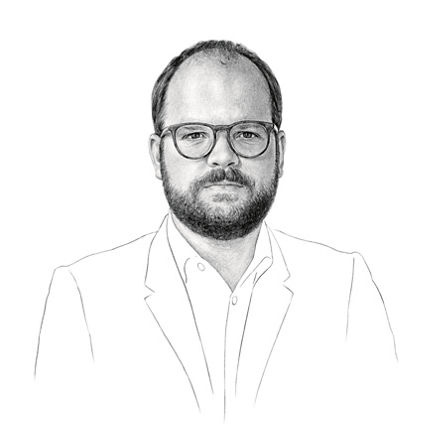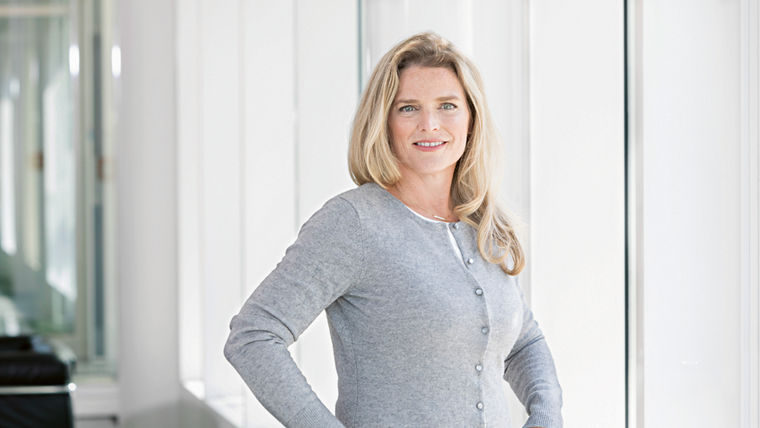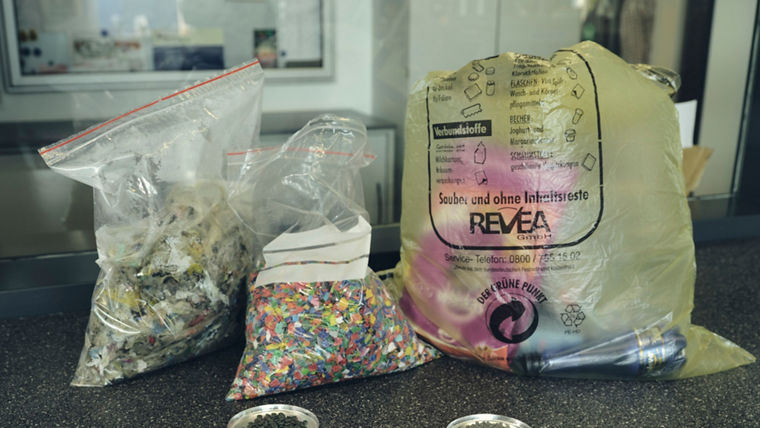The modern-day Sisyphus is called ROBB-AQC. He’s a black-and-yellow robot whose jagged arm movements tirelessly extract plastic bottles and foil from an endless stream of garbage. Sensors and artificial intelligence tell him where recyclable plastics are flowing by on the conveyor belt. Nonetheless, many recyclable items remain on the belt. “This is a test operation! He’s still learning,” shouts Frank Arleth above the noise as he pulls a fleece jacket off the conveyor belt after it has got stuck under the robot’s arm. Arleth and the robot both work for the Hündgen waste management company in the town of Swisttal near Bonn. This family-owned company has been run as a waste management facility for more than 70 years, and in the past 30 years it has sorted the contents of yellow recycling sacks for waste made of plastic, metal or composite materials.
The company has 140 employees, including many truck drivers. They collect the category of waste known here as “recyclables” from a wide region—up to 450 tons of it per day. Their field of operation ranges from the northern Ruhr region down to the Hunsrück Ridge in the south. Piled up in the incoming warehouse you can even see stacks of waste packaging from Denmark. Two years ago the owners of this midsized company spent about €15 million to install one of the most modern sorting facilities in Germany. This facility has to operate at full capacity. The machines run day and night, seven days a week. Saturday is also cleanup day.

THE JOB OF THE CENTURY
More than 350 million tons of plastic are produced annually all over the world—more than 200 times the volume produced in 1950, when the age of plastic really took off. Since then about ten billion tons of plastic have been produced, more than half of it since 2000.
In the past few decades, only a fraction of this amount has been recycled. Even most of the plastic materials that are produced worldwide today finally end up in landfills—or, in the worst of cases, in the natural environment. Because plastics do not deteriorate even after hundreds of years, the mountain of garbage is steadily growing—with devastating effects on habitats all over the planet. Plastic is everywhere. Finely ground into microplastic particles, it has even entered our food chains.
For a long time now, it has been obvious that this situation is untenable. One approach to a solution that almost everyone can agree on is “collect, process, recycle”. “Circular plastics” denotes the dream of a closed cycle in which plastic materials are reused over and over again. The specialty chemicals company Evonik wants to help reach this goal on several different levels. All of these efforts were recently consolidated in Evonik’s Global Circular Plastics Program.

Global Circular Plastics Program
Evonik is consolidating its plastic recycling activities in the new Global Circular Plastics Program. The company offers solutions for improving the efficiency and quality of mechanical recycling and is working on various technologies for chemical recycling. At the same time, Evonik is investigating how raw materials derived from plastic or organic waste, for example, and CO2 from biogas and industrial emissions can be used for the production of chemicals. By increasing its use of renewable raw materials for its own production processes, Evonik is improving its own CO2 footprint and raising the proportion of sustainable materials used by its customers. Evonik serves the entire value chain of the plastics cycle and expects its sales to increase by more than €350 million annually starting in 2030.

YOU CAN'T DO WITHOUT IT
Environmental protection associations are calling on people to use less plastic overall. But even they don’t expect us to ever do entirely without plastics. Without the use of plastic, medical equipment ranging from disposable syringes to rubber gloves would no longer be safe. Plastic materials insulate buildings and refrigerators, help to reduce fuel consumption by means of lightweight components in vehicles, lengthen the shelf life of foods when used in packaging, and thus reduce food waste. Electric vehicles, wind power, solar energy—many promising technologies for conserving the natural environment would not exist without plastic. However, almost half of the plastic produced today is processed into packaging materials that become garbage practically overnight.
In order to get this torrent under control, old packaging has to be turned into new. But in many places the existing laws make it difficult to reach this goal. For example, in Germany the plastics that are collected in special yellow sacks may not be recycled to make food packaging, because the possibility of contamination by pollutants at some point in the process cannot be fully excluded. But recyclates from Almost fully automatic: Cameras, artificial intelligence, and robots are helping to identify and separate different kinds of plastic old plastic are seldom used even for packaging that does not come into contact with food, because the quality of these recyclates varies greatly.
Three types of plastic play a major role in packaging today: polypropylene (PP), various types of polyethylene (PE), and polyethylene terephthalate (PET). Together, they account for by far the largest proportion of all the materials used to make bags, tubs, foils, bottles, and other types of packaging, as well as objects for everyday use (see the infographic on page 18). After being used, each of these three plastics can be easily melted and reprocessed more than once.
The only problem is that they should not be mixed. Even a few percent of PP in a foil made of PE make it impossible to tightly seal a piece of packaging. This is why companies such as Hündgen use state-of-the-art technology to sort out these three kinds of plastic and keep them strictly separate. Recently robots have been brought in to supplement the sorting machines, whose cameras use near-infrared and ultraviolet light to distinguish between the different plastic molecules and then blow the respective plastic parts out of the stream of garbage with targeted blasts of air.

Every scrap of plastic that Hündgen cannot identify, pull out, and market as a recyclable material is incinerated, either in refuse incineration plants or as a “substitute fuel” in cement plants, for example. These residual amounts, whose recovery Hündgen must pay for, account for just over 40 percent of the contents of a yellow sack. That’s why the company has recently started to use some technical refinements to extract an additional two percent of mixed plastic scraps from the waste flow. The gray agglomerate is used to make park benches, playground equipment, and terrace substructures. This is certainly good for the recycling ratio, but it’s still not a contribution to a genuine circular economy.
The huge balls of PP, PE, and PET that roll out of the Hündgen company’s courtyard offer old plastics better opportunities for having a new life as packaging materials. They are reprocessed by companies such as RE Plano in the town of Lünen near Dortmund. RE Plano is part of the Remondis Group, a giant in the recycling and waste sector that employs 36,000 men and women at 900 locations. The Lippewerk waste recycling center in Lünen, which covers an area of 230 hectares, is considered the biggest in Europe. Here a million tons of garbage, ranging from organic waste to electronic parts and metal slag, are reprocessed annually. RE Plano mainly handles PE and PP, while a sister company treats PET.

CONSUMPTION INCREASES

WASHING, SORTING, BLOW-DRYING
In the first step, the bales of plastic waste are shredded and washed so that the presorted packaging materials can be transformed into recycling granulate that is as pure as possible and thus can be processed like new plastic. “The exact details of the process are a trade secret,” says Monica Harting Pfeiffer, a process engineer who works as a project manager at RE Plano. But she does divulge that “we produce a lye that we use to remove glued-on labels and imprints.” After that, the washed and dried flakes of plastic are sorted again in order to separate shredded PE bottles from chopped-up labels, for example. One of the methods used for this purpose is air separation, which exploits the differences between the particles’ shapes and flight characteristics.

“The materials that are practically impossible to separate are multilayer films made of several different plastics,” Harting Pfeifer explains. However, these multilayer films are the current front-runners in the packaging market. For the packaging of wet or oily products ranging from coffee to dog food, manufacturers use pouches that may consist of more than a dozen layers of glued or vapor-deposited plastic. Such pouches are light-proof, odor-proof, and very robust. In general, very little material is needed to produce them. There’s only one problem: It’s nearly impossible to separate and recycle their component materials.
At Evonik’s Goldschmidtstraße location in Essen, these are very familiar difficulties. Three years ago, the specialty chemicals company expanded the location’s application laboratory and its adjacent technical center so that it could examine the recycling companies’ problems in depth. “Until a few years ago, these companies were practically not a market for us,” says Kathrin Lehmann, Technical Director Polymer Specialities. “But today we’re seeing a huge change.”
CUSTOMIZED FORMULATIONS
Evonik has supplied additives and auxiliary materials to the plastics industry for decades. These materials improve the properties of the end products, for example by making them flame-retardant, more fluid, scratchproof or more pleasant to the touch. Of course many of these properties would also be in demand when recyclates are being processed. “However, the details of the requirements are different, and we’re finding out that we can bring even more of our know-how to bear in the recycling sector,” Lehmann says.
One of these areas is that of washing and sorting. Lehmann’s team regularly analyzes samples of washing lyes that are sent to it by companies such as RE Plano. The team members develop customized formulations for surfactants that are used in de-inking and de-labeling processes that quickly remove inks and labels without leaving any residue. Anti-foaming agents simplify the washing process by preventing foam from overflowing. Wetting agents enable the lye to slip between the surfaces more easily, and desiccants help to save energy in the subsequent drying process. “This process know-how, which we have accumulated over decades for other processing industries, is now being combined and used in the recycling business,” Lehmann says.
Next door, a team headed by Sebastian Heßner is working with extruders and foil-packaging machines to determine how additives from Evonik can play a role in the preparation and processing of plastics for recycling. “Some of the requirements are the same as those for virgin plastic—in other words, new materials,” explains Heßner, who is the head of the testing facility. “But there are additional requirements as well.” For example, because the starting materials are more diverse, their flowing and melting properties must be finetuned more often.

LOCKED-IN ODORS
Another typical problem involves odors. “If recyclates contain organic compounds or adhesive residues and they are heated during the extruding process, they generate volatile and strong-smelling degradation products that take a long time to dissipate,” Heßner explains. That’s why you can sometimes simply follow your nose in a DIY store if you’re looking for inexpensive recycling products such as buckets or garden furniture. “Some recycling companies deal with this problem by adding aromatic substances,” Heßner says. “By contrast, our odor absorbers don’t simply mask the odor temporarily. Instead, they permanently keep the volatile molecules inside the material.”
Today Evonik may even have two solutions ready for the multilayer films that are driving recycling companies to despair. Kathrin Lehmann goes to a cupboard and pulls out a rolled-up film that was recently sent to her by a packaging manufacturer from Asia. Before the covid-19 pandemic, the two of them had started talking at a trade fair. Lehmann now points with visible satisfaction at a beaker in which two extremely thin films are floating around companionably—one is plastic, the other one is aluminum. “By using the right surfactants, we can separate even this kind of film with 100 percent precision. No problem!” she says.

Whenever this kind of separation is impossible, the job is turned over to Sebastian Babik. “Sometimes materials that are chemically different can be married and then recovered together,” he says. Babik’s title at Evonik is “Director Technology Platform Polyolefins,” and the name of his solution is VESTOPLAST ®. This polyolefin, which was developed in-house at Evonik, is a component of the hot glues that are used today to keep diapers, sanitary pads, and cartons in one piece. As a chemical relative of PE and PP, VESTOPLAST® can also make these two materials compatible with each other, Babik explains. “In tests we conducted in cooperation with TU Wien, we were able to generate new recycling materials consisting of two thirds PE and one third PP that have significantly improved physical properties,” he says. This is good news for all companies that plan to use more recyclates themselves in the future and still find it difficult to procure enough high-quality material today.
For example, in 2019 the Henkel Group used a total of 769,000 tons of packaging material for its consumer products, including well-known brands such as Pattex, Persil, Schwarzkopf, and Sidolin. About half of this packaging was made of plastic. Henkel plans to make all of its packaging reusable or recyclable by 2025, and at least 30 percent of it will consist of recyclates. This will be a challenge for the product designers. “Consumers have high expectations,” says Thorsten Leopold, Director Global Packaging Innovation in the Home Care business unit at Henkel. “They want sustainable products and packaging, but they don’t want to make any compromises regarding the color, odor, tactile qualities or functionality of the packaging.”
RETHINKING AND LEARNING
Meanwhile, the group’s adhesives unit is also providing support for supplier companies: Labels, cartons, and lots of multilayered packaging owe their sturdiness to adhesives from Henkel. “Our customers have recently experienced a genuine change of heart,” says Dennis Bankmann, Senior Manager Circular Economy at Henkel Adhesive Technologies. “Until a few years ago, they always wanted everything to be even more solid, more temperature-resistant, and more long-lived. Today customers are also asking how all these things can be dismantled.” As a result, they’re now using plastic banderoles that are only attached at a few points instead of fully glued-down paper labels, for example. Henkel has developed an adhesive for outer packaging that eliminates the need to shrink-wrap cartons in order to keep them from rolling off a pallet.
Here Evonik is needed yet again, because it’s a supplier upstream in the value chain. Evonik supplies not only VESTOPLAST ® but also countless other components for adhesives that hold all kinds of things together, ranging from yogurt containers to cardboard boxes. “For a long time now, gluing and ungluing have not been the only issues,” says Babik. “There’s also the question of how the glue itself behaves in the recycling process. Nowadays customers are simply looking much more closely.”
This rethinking, as well as the sum total of countless small solutions to problems, is giving people hope. Legislators all over the world are creating pressure, increasing the waste collection and recycling quotas, and calling industries, trading companies, and consumers to account. Sorting companies, recyclers, packaging manufacturers, producers of consumer goods, and the chemical industry are reacting by looking for new paths out of the current impasse. The outlines of a circular economy for the packaging industry are still vague, but they are discernible. Closing the global circle once and for all will be the job of the century. There’s still a lot to learn. Not just for the busy robot by the conveyor belt.

THE MAIN GROUPS




